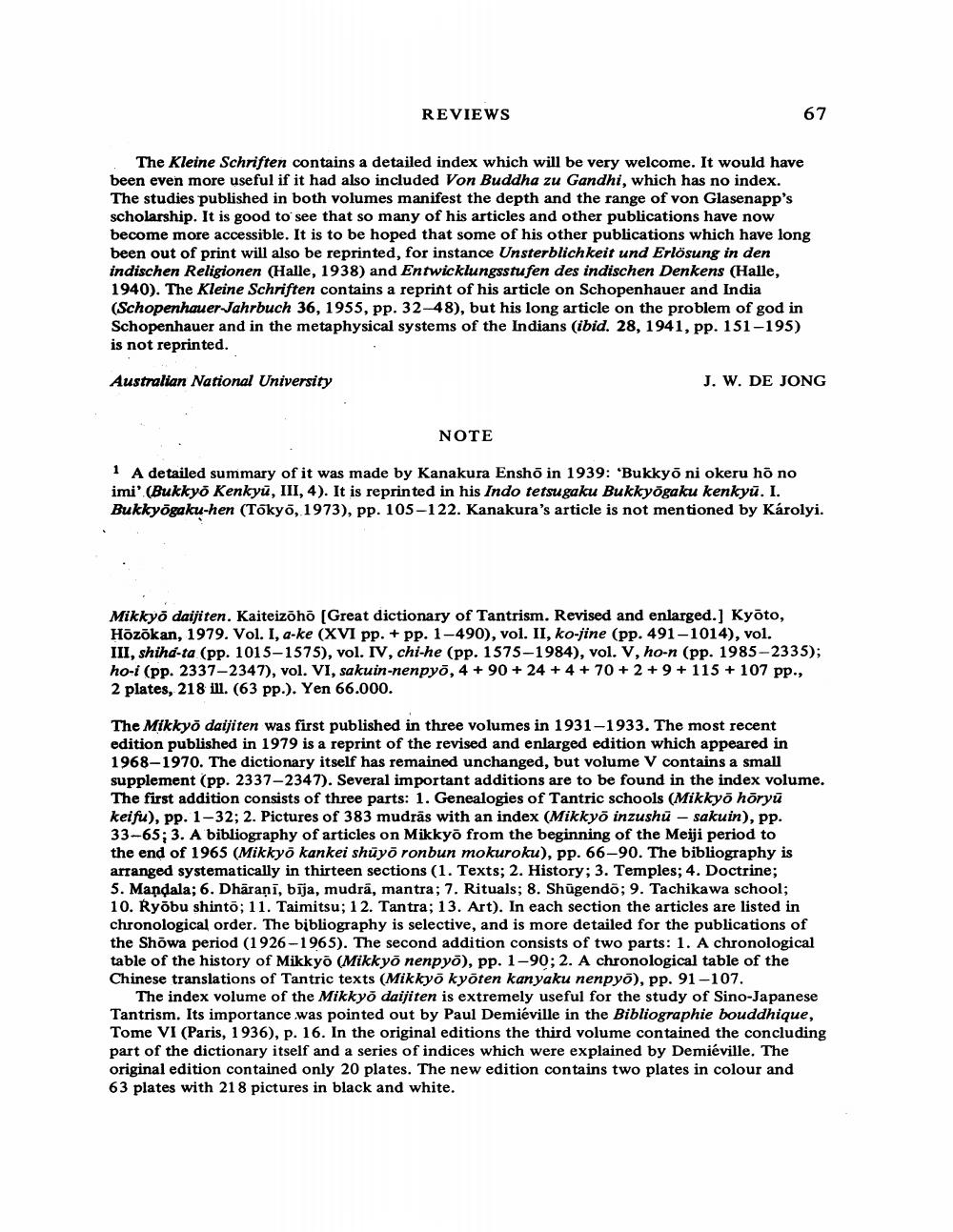Book Title: Book Reviews Author(s): J W De Jong Publisher: J W De Jong View full book textPage 9
________________ REVIEWS 67 The Kleine Schriften contains a detailed index which will be very welcome. It would have been even more useful if it had also included Von Buddha zu Gandhi, which has no index. The studies published in both volumes manifest the depth and the range of von Glasenapp's scholarship. It is good to see that so many of his articles and other publications have now become more accessible. It is to be hoped that some of his other publications which have long been out of print will also be reprinted, for instance Unsterblichkeit und Erlösung in den indischen Religionen (Halle, 1938) and Entwicklungsstufen des indischen Denkens (Halle, 1940). The Kleine Schriften contains a reprint of his article on Schopenhauer and India (Schopenhauer-Jahrbuch 36, 1955, pp. 32-48), but his long article on the problem of god in Schopenhauer and in the metaphysical systems of the Indians (ibid. 28, 1941, pp. 151-195) is not reprinted. Australian National University NOTE J. W. DE JONG 1 A detailed summary of it was made by Kanakura Enshō in 1939: 'Bukkyō ni okeru hō no imi' (Bukkyō Kenkyu, III, 4). It is reprinted in his Indo tetsugaku Bukkyōgaku kenkyū. I. Bukkyōgaku-hen (Tōkyō, 1973), pp. 105–122. Kanakura's article is not mentioned by Károlyi. Mikkyō daijiten. Kaiteizōhō [Great dictionary of Tantrism. Revised and enlarged.] Kyōto, Hōzōkan, 1979. Vol. I, a-ke (XVI pp. + pp. 1-490), vol. II, ko-jine (pp. 491-1014), vol. III, shihd-ta (pp. 1015-1575), vol. IV, chi-he (pp. 1575-1984), vol. V, ho-n (pp. 1985-2335); ho-i (pp. 2337-2347), vol. VI, sakuin-nenpyō, 4+ 90 + 24 +4 + 70+2+9+115+ 107 pp., 2 plates, 218 ill. (63 pp.). Yen 66.000. The Mikkyō daijiten was first published in three volumes in 1931-1933. The most recent edition published in 1979 is a reprint of the revised and enlarged edition which appeared in 1968-1970. The dictionary itself has remained unchanged, but volume V contains a small supplement (pp. 2337-2347). Several important additions are to be found in the index volume. The first addition consists of three parts: 1. Genealogies of Tantric schools (Mikkyō hōryū keifu), pp. 1-32; 2. Pictures of 383 mudras with an index (Mikkyō inzushū – sakuin), pp. 33-65; 3. A bibliography of articles on Mikkyō from the beginning of the Meiji period to the end of 1965 (Mikkyō kankei shūyō ronbun mokuroku), pp. 66-90. The bibliography is arranged systematically in thirteen sections (1. Texts; 2. History; 3. Temples; 4. Doctrine; 5. Mandala; 6. Dharaṇī, bija, mudra, mantra; 7. Rituals; 8. Shugendō; 9. Tachikawa school; 10. Ryōbu shinto; 11. Taimitsu; 12. Tantra; 13. Art). In each section the articles are listed in chronological order. The bibliography is selective, and is more detailed for the publications of the Shōwa period (1926-1965). The second addition consists of two parts: 1. A chronological table of the history of Mikkyō (Mikkyō nenpyo), pp. 1-90; 2. A chronological table of the Chinese translations of Tantric texts (Mikkyō kyōten kanyaku nenpyō), pp. 91–107. The index volume of the Mikkyō daijiten is extremely useful for the study of Sino-Japanese Tantrism. Its importance was pointed out by Paul Demiéville in the Bibliographie bouddhique, Tome VI (Paris, 1936), p. 16. In the original editions the third volume contained the concluding part of the dictionary itself and a series of indices which were explained by Demiéville. The original edition contained only 20 plates. The new edition contains two plates in colour and 63 plates with 218 pictures in black and white.Page Navigation
1 ... 7 8 9 10 11 12 13 14 15 16 17 18 19 20 21 22 23 24 25 26 27 28 29 30 31 32 33 34 35 36 37 38 39
